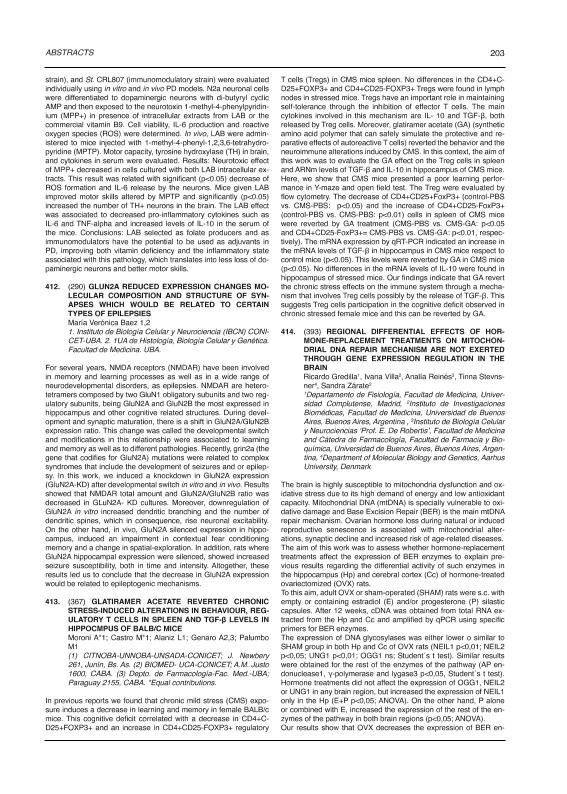Mostrar el registro sencillo del ítem
dc.contributor.author
Gredilla, Ricardo
dc.contributor.author
Villa, Ivana
dc.contributor.author
Reines, Analia Gabriela

dc.contributor.author
Stevnsner, Tinna
dc.contributor.author
Zarate, Sandra Cristina

dc.date.available
2023-08-24T14:50:51Z
dc.date.issued
2021
dc.identifier.citation
Regional differential effects of hormone-replacement treatments on mitochondrial DNA repair mechanism are not exerted through gene expression regulation in the brain; LXVI Reunión Anual de la Sociedad Argentina de Investigación Clínica; LXIX Reunión Anual de la Sociedad Argentina de Inmunología; LIII Reunión Anual de la Asociación Argentina de Farmacología Experimental y XI Reunión Anual De La Asociación Argentina De Nanomedicinas; Argentina; 2021; 203-204
dc.identifier.issn
1669-9106
dc.identifier.uri
http://hdl.handle.net/11336/209283
dc.description.abstract
The brain is highly susceptible to mitochondria dysfunction and oxidative stress due to its high demand of energy and low antioxidant capacity. Mitochondrial DNA (mtDNA) is specially vulnerable to oxidative damage and Base Excision Repair (BER) is the main mtDNA repair mechanism. Ovarian hormone loss during natural or induced reproductive senescence is associated with mitochondrial alterations, synaptic decline and increased risk of age-related diseases.The aim of this work was to assess whether hormone-replacement treatments affect the expression of BER enzymes to explain previous results regarding the differential activity of such enzymes in the hippocampus (Hp) and cerebral cortex (Cc) of hormone-treated ovariectomized (OVX) rats. To this aim, adult OVX or sham-operated (SHAM) rats were s.c. with empty or containing estradiol (E) and/or progesterone (P) silastic capsules. After 12 weeks, cDNA was obtained from total RNA extracted from the Hp and Cc and amplified by qPCR using specific primers for BER enzymes.The expression of DNA glycosylases was either lower o similar to SHAM group in both Hp and Cc of OVX rats (NEIL1 p<0,01; NEIL2 p<0,05; UNG1 p<0,01; OGG1 ns; Student´s t test). Similar results were obtained for the rest of the enzymes of the pathway (AP endonuclease1, γ-polymerase and lygase3 p<0,05, Student´s t test). Hormone treatments did not affect the expression of OGG1, NEIL2 or UNG1 in any brain region, but increased the expression of NEIL1 only in the Hp (E+P p<0,05; ANOVA). On the other hand, P alone or combined with E, increased the expression of the rest of the enzymes of the pathway in both brain regions (p<0,05; ANOVA).Our results show that OVX decreases the expression of BER enzymes in both brain regions and that there is no association between ARNm levels and the activity of such enzymes in hormone-treated rats. Thus, hormones exert their regional differential action on BER pathway through a mechanism not involving gene regulation.
dc.format
application/pdf
dc.language.iso
eng
dc.publisher
Fundación Revista Medicina
dc.rights
info:eu-repo/semantics/openAccess
dc.rights.uri
https://creativecommons.org/licenses/by-nc-sa/2.5/ar/
dc.subject
MITOCHONDRIA
dc.subject
BRAIN
dc.subject
DNA REPAIR
dc.subject
HORMONE REPLACEMENT TREATMENT
dc.subject.classification
Neurociencias

dc.subject.classification
Medicina Básica

dc.subject.classification
CIENCIAS MÉDICAS Y DE LA SALUD

dc.title
Regional differential effects of hormone-replacement treatments on mitochondrial DNA repair mechanism are not exerted through gene expression regulation in the brain
dc.type
info:eu-repo/semantics/publishedVersion
dc.type
info:eu-repo/semantics/conferenceObject
dc.type
info:ar-repo/semantics/documento de conferencia
dc.date.updated
2022-11-09T18:53:50Z
dc.journal.volume
81
dc.journal.number
III
dc.journal.pagination
203-204
dc.journal.pais
Argentina

dc.journal.ciudad
Buenos Aires
dc.description.fil
Fil: Gredilla, Ricardo. Universidad Complutense de Madrid; España
dc.description.fil
Fil: Villa, Ivana. Consejo Nacional de Investigaciones Científicas y Técnicas. Oficina de Coordinación Administrativa Houssay. Instituto de Investigaciones Biomédicas. Universidad de Buenos Aires. Facultad de Medicina. Instituto de Investigaciones Biomédicas; Argentina
dc.description.fil
Fil: Reines, Analia Gabriela. Consejo Nacional de Investigaciones Científicas y Técnicas. Oficina de Coordinación Administrativa Houssay. Instituto de Biología Celular y Neurociencia "Prof. Eduardo de Robertis". Universidad de Buenos Aires. Facultad de Medicina. Instituto de Biología Celular y Neurociencia; Argentina
dc.description.fil
Fil: Stevnsner, Tinna. Aarhus University. Department of Bioscience; Dinamarca
dc.description.fil
Fil: Zarate, Sandra Cristina. Consejo Nacional de Investigaciones Científicas y Técnicas. Oficina de Coordinación Administrativa Houssay. Instituto de Investigaciones Biomédicas. Universidad de Buenos Aires. Facultad de Medicina. Instituto de Investigaciones Biomédicas; Argentina
dc.relation.alternativeid
info:eu-repo/semantics/altIdentifier/url/https://medicinabuenosaires.com/revistas/vol81-21/s3/Mv81s3.pdf
dc.conicet.rol
Autor

dc.conicet.rol
Autor

dc.conicet.rol
Autor

dc.conicet.rol
Autor

dc.conicet.rol
Autor

dc.coverage
Nacional
dc.type.subtype
Reunión
dc.description.nombreEvento
LXVI Reunión Anual de la Sociedad Argentina de Investigación Clínica; LXIX Reunión Anual de la Sociedad Argentina de Inmunología; LIII Reunión Anual de la Asociación Argentina de Farmacología Experimental y XI Reunión Anual De La Asociación Argentina De Nanomedicinas
dc.date.evento
2021-11-17
dc.description.paisEvento
Argentina

dc.type.publicacion
Journal
dc.description.institucionOrganizadora
Sociedad Argentina de Investigación Clínica
dc.description.institucionOrganizadora
Sociedad Argentina de Inmunología
dc.description.institucionOrganizadora
Asociación Argentina de Farmacología Experimental
dc.description.institucionOrganizadora
Asociación Argentina de Nanomedicinas
dc.source.revista
Medicina

dc.date.eventoHasta
2021-11-20
dc.type
Reunión
Archivos asociados
